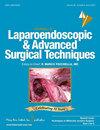Impact of the COVID-19 Lockdown on Primary Bariatric Surgery: A Comparative Study of Weight Loss Trajectories and Perioperative Outcomes.
IF 1.1
4区 医学
Q3 SURGERY
Journal of Laparoendoscopic & Advanced Surgical Techniques
Pub Date : 2024-09-13
DOI:10.1089/lap.2024.0241
引用次数: 0
Abstract
Background: The COVID-19 pandemic and subsequent lockdowns led to substantial changes in health-related behaviors and deferred elective surgeries. This study aimed to evaluate the impact of the COVID-19 lockdown on weight loss trajectories (WLT) and perioperative outcomes in primary bariatric surgery at a single tertiary referral center. Methods: Patients who underwent primary bariatric surgery immediately prior to the enforced lockdown (During-Lockdown Group, DLG) were compared with historical controls who underwent surgery before the lockdown (Before-Lockdown Group, BLG). WLT were estimated using a random intercept mixed-effects model with repeated measures. Cross-sectional group differences at 3- and 6-months post-surgery were examined. Perioperative outcomes were also analyzed. Results: A total of 273 patients were included (133 BLG, 140 DLG). The adjusted average weight decreased in both groups over time at different levels. The expected difference in weight between BLG and DLG at 3-months was 1.06 kg (P = .013) and at 6-months was .04 kg (P = .920), respectively. There were no statistically significant differences in postoperative complications, emergency department visits, re-admission rates, re-operation rates, or mortality. Conclusions: This study suggests that bariatric procedures performed before the COVID-19 lockdown were effective and safe. Despite a statistically significant difference in weight between groups at 3- and 6-months post-surgery, the difference was small and unlikely to be clinically significant. Short-term outcomes were comparable between the two groups. Further investigation is warranted to assess the impact of lifestyle changes during the lockdown on long-term bariatric surgery outcomes.COVID-19 封锁对初级减肥手术的影响:减肥轨迹和围手术期结果的比较研究。
背景:COVID-19 大流行和随后的封锁导致了健康相关行为的重大改变和择期手术的推迟。本研究旨在评估 COVID-19 封锁对一家三级转诊中心初级减肥手术的减重轨迹 (WLT) 和围手术期结果的影响。方法将在强制封锁前接受初级减肥手术的患者(封锁期间组,DLG)与在封锁前接受手术的历史对照组(封锁前组,BLG)进行比较。WLT 采用随机截距重复测量混合效应模型进行估计。检查了手术后 3 个月和 6 个月的横截面组间差异。同时还分析了围手术期的结果。结果:共纳入 273 名患者(133 名 BLG,140 名 DLG)。随着时间的推移,两组患者调整后的平均体重均有不同程度的下降。BLG 和 DLG 在 3 个月时的预期体重差异分别为 1.06 千克(P = .013)和 0.04 千克(P = .920)。术后并发症、急诊就诊率、再次入院率、再次手术率或死亡率在统计学上没有明显差异。结论:这项研究表明,在 COVID-19 封锁前进行的减肥手术是有效和安全的。尽管两组患者在术后 3 个月和 6 个月时的体重在统计学上有显著差异,但差异很小,不太可能具有临床意义。两组的短期疗效相当。有必要进行进一步调查,以评估禁食期间改变生活方式对长期减肥手术效果的影响。
本文章由计算机程序翻译,如有差异,请以英文原文为准。
求助全文
约1分钟内获得全文
求助全文
来源期刊
CiteScore
2.90
自引率
0.00%
发文量
163
审稿时长
3 months
期刊介绍:
Journal of Laparoendoscopic & Advanced Surgical Techniques (JLAST) is the leading international peer-reviewed journal for practicing surgeons who want to keep up with the latest thinking and advanced surgical technologies in laparoscopy, endoscopy, NOTES, and robotics. The Journal is ideally suited to surgeons who are early adopters of new technology and techniques. Recognizing that many new technologies and techniques have significant overlap with several surgical specialties, JLAST is the first journal to focus on these topics both in general and pediatric surgery, and includes other surgical subspecialties such as: urology, gynecologic surgery, thoracic surgery, and more.

 求助内容:
求助内容: 应助结果提醒方式:
应助结果提醒方式:


